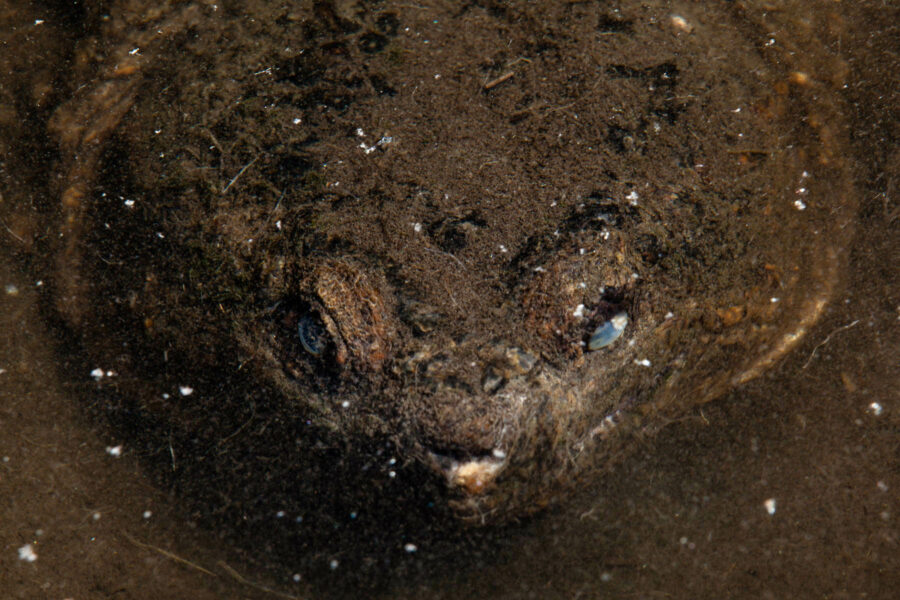Formidable jaws deserve applause

Living in brackish water and freshwater lakes, streams and rivers, the common snapping turtle inhabits all of the Chesapeake Bay watershed and a large portion of North America. In fact, the “common” part of its name refers to the large territory it inhabits. The large reptile is frequently seen by residents during the summer months when it is traveling to and from nesting grounds.
With large claws, an alligator-like tail, thick shell and scaled legs, the common snapping turtle might make you think it’s related to a dinosaur. The species isn't quite that old, but with a close relative dating back 40 million years the reptile is certainly an ancient species that perfectly adapted to their environment and has not significantly changed since they first developed.
To survive the cold winters of North America, these turtles bury themselves in the mud, slow down their metabolism and absorb dissolved oxygen from the surrounding water. During the warmer months when they are active, they have a voracious appetite and will eat almost anything they can wrap their jaws around including amphibians, reptiles, fish, small mammals, baby birds and aquatic plants. During times of food scarcity, this varied diet helps them survive.
As apex predators, snapping turtles serve an important role in the local ecosystem. Like vultures of the water, they keep waterways clean by eating diseased and decaying animals. Each summer, their eggs and young feed a wide range of other animals over a large portion of the United States. In turn, the hatchlings that survive to adulthood eat other water-dwelling creatures keeping the entire food web balanced.
Snapping turtles as food
Snapping turtles are still considered a game animal in many states and have a long history of being used in traditional recipes in North America.
The common snapping turtle population is considered stable but the growing turtle trade caused jurisdictions of the Chesapeake Bay watershed to enforce stricter harvesting laws to maintain the population. In 2019, the Commonwealth of Virginia enforced stricter regulations on the industry to help the population rebound after a study showed a decline . Harvested snapping turtles are used locally but also shipped overseas to meet a growing demand for exported turtles. They’re also are shipped live for aquaculture operations and as canned food products.
Although there are no fish consumption advisories for turtles, as a large predatory aquatic species they can accumulate toxins and residents should always check water quality warnings before consuming turtles and fish.
When you might see a snapping turtle and what to do if you do
Turtles are often seen on land during late spring when females are finding nesting sites, and in the fall when hatchlings are traveling to new territory. In the water, snapping turtles have very few predators once they reach adulthood and are much calmer. On land, snapping turtles are much more defensive. Without the ability to pull their heads into their shells for defense, snapping turtles don’t let people get close and will readily strike. With a deceptively long neck and a strike distance of one-half to two-thirds of their shell length, they can become a serious threat. Snapping turtles are best left on their own and should rarely be handled.
If a snapping turtle must be moved:
- Make sure it is safe for you to approach the turtle by checking for traffic if you are on a public road.
- Never grab a turtle by their tail, it is connected to their spine and grabbing it can permanently injure the turtle. The only safe place to hold a snapping turtle is by the back of their shell, safely out of the reach of their long neck.
- Always move the turtle in the direction it was traveling.
The snapping turtle certainly won’t be making any appearances at the local petting zoo, but its ability to survive over millions of years and its role in the local ecosystem should be appreciated, from a safe distance of course.

Comments
I found a tiny snapping on our road on April 20. I saw something on the road as I was getting the mail from the mailbox. I thought it was an insect, but when I went to pick it up, I could see it was a tiny snapping turtle. We see grown snapping turtles in the Spring when they travel between ponds. Because of all the housing construction in our area, we have noticed a decline in box turtles, which used to be a Springtime ritual - moving turtles from the road to the side they were headed, but I haven't seen any this year. The little turtle seemed to be glad to reach the pond bank, and crawled right to the water, swam a couple of strokes on the water before swimming below the surface. I hope he has a chance to grow a hard shell before the blue herons come.
Thank you!
Your comment has been received. Before it can be published, the comment will be reviewed by our team to ensure it adheres with our rules of engagement.
Back to recent stories